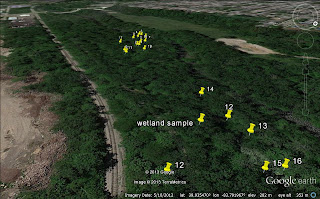“A process of critical thinking
that uses observations and experiments to investigate testable predictions
about the physical universe.” By using the scientific method throughout our
class experiment we have attempted to dissect the more complex issue into
smaller parts to help us better understand our experiment and purpose. We want to know does this high resolution
small scale experiment help us understand trends for the large scale rivers
that serve as tributaries to Buck Creek. The steps of the method we have used
in our tests are choosing a guiding question to go along with our controlled
experiment to seek out the big picture in our study. Our hypothesis or guiding question is by
examining Buck Creek and its surrounding wetlands does the water quality
improve with increased nitrogen and more organisms as the water travels its
course through the sub-tributaries of the river. To investigate our hypothesis
we have put in place procedures of sampling and recording
our results to put together a data set we can show and interpret at GSA.
We have collected ion concentrations by using
an automatic sampling ion chromatograph(pictured above).
An ion chromatograph analyzes the concentrations of various ions that
are in the samples. This is done by using
standard solutions that we create with concentrations within the expected range
for each ion. The chromatograph then
uses these standard solutions to create an equation to find the concentrations
of the unknown samples. As the sample
travels through the machine each ion travels at different speeds and the
machine measures this speed and produces peeks(sample peaks pictured below).
The area is then found and can correlate to what the concentrations of
the ions are.
With the small scale data we can
observe how our local impact is affecting the larger tributaries such as the
Ohio and Mississippi Rivers.
-Beth and Grant
Sources used:
http://srel.uga.edu/kidsdoscience/sci-method-planes/Sci-method-definitions.pdf
-Beth and Grant
Sources used:
http://srel.uga.edu/kidsdoscience/sci-method-planes/Sci-method-definitions.pdf


